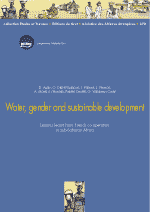Water, gender and sustainable development
 |
Lessons learnt from French co-operation in sub-Saharan Africa
livre coll. Etudes et travaux n° 23 Mar 2002 ; 112 pages ; prix indicatif: 13€
Aut.
Ed. GRET - Nogent sur Marne ; Isbn: 2-86844-120-3
Téléchargeable sous format: PdF
 Eau, genre et développement durable
Abstract:
Eau, genre et développement durable
Abstract:Because women's contribution to development is still poorly recognised, if not undervalued, this document attempts to draw up a full picture of how men and women are taken into account in development activities in the field of water and sanitation.
It draws extensively on lessons learnt in the context of French co-operation. The work begins by reviewing the main changes to have occurred since the 1970s not only in international meetings, in research, and in terminology, but also in specific approaches aimed at involving women in development processes. It goes on to describe the "traditional" ways in which power is shared between social groups in African societies (according to criteria of age, ethnic group, status, religion and gender).
The third part analyses the perceptions, knowledge and practices of male and more specifically female users, since the latter play a predominant part in relation to water and sanitation. Next, using case studies, the way in which the various types of user are taken into account, at all stages of hydraulics projects, is explored.
The final part defines what is meant by a demand-driven approach, and presents the various ways in which this can be evaluated.
In the light of all these observations, the work ends with recommendations drawn up jointly by the French Ministry of foreign affairs and the French development agency (AFD) with the objective of effectively involving users as a whole in water and sanitation management. Contents:
Chapter One
A brief history of women in development
1. Introduction
2. Major international conferences
2.1. From good intentions to reality
2.2. Conferences on development. One sure fact: without women - no sustainable impact
2.3. Water conferences. Sharing cross-gender development
2.4. Activism and Action Research
3. How concepts have changed
3.1. Introduction
3.2. Changing approaches to the integration of women
4. Conclusions
5. Bibliography for Chapter 1
6. Annex. UN Conferences
Chapter 2
Power sharing and social change
1. Introduction
2. Women and social organisation
2.1. The family: a unit taking many forms
2.2. "Elders" or the formal guardians of conformity
2.3. From compulsory consensus to community seizure of power
2.4. Women and the public domain
3. Migrations and education: the new picture
3.1. Women's increasing responsibility as a result of migration
3.2. Household diversity and poverty
3.3. Literacy and training contribute gradually to emancipation
4. What role do non-profit associations play in changes in how society is organised ?
4.1. The example of non-profit associations in semi-urban areas in Benin
4.2. The example of women's associations in Senegal
4.3. Associations for improving the environment in Ouagadougou
6. Bibliography for Chapter 2
Chapter 3
Domestic water and sanitation management
1. Introduction: domestic economy and gender
2. Household water supply practices
2.1. The "water chore"
2.2. Criteria for choosing a drinking water supply source
2.3. Sharing the cost of water
2.4. Traditional perceptions of links between water and health
3. Sanitation: a neglected field
3.1. Cause for concern
3.2. The predominant role of women
3.3. Evacuating household wastewater: practices and behaviour
3.4. Attitudes and demands for improvement
4. Conclusions
5. Bibliography for Chapter 3
Chapter 4
Male and female users: their place and role
1. Introduction
2. Project objectives and stakeholder expectations
2.1. The State
2.2. Users
2.3. Funding agencies
3. Evaluating demand in preliminary studies
3.1. Needs assessment
3.2. An environment scarcely conducive to wide popular participation, and notably that of women
3.3. Poorly understood demand
4. Management and user participation
4.1. The Management Committee, modelled on "participatory" social engineering
4.2. User participation in managing DWS systems
5. Project results and evaluation
6. Conclusions
7. Bibliography for Chapter 4
Chapter 5
Methodological aspects
1. The similarities between the gender approach and a demand driven strategy
1.1. What is demand?
1.2. Why a demand driven approach?
2. Demand evaluation
2.1. The methods available
2.2. General household surveys and revealed preference surveys
2.3. Participatory evaluation methods
2.4. Contingent valuation methods
3. Expected impact of these methods
4. Bibliography for Chapter 5
Chapitre 6
Recommendations
Ministry of Foreign Affaires and French development
agency (AFD) recommendations
Mots clefs: |
alimentation en eau saine (CI) (DT) (OP) (ope) , assainissement (CI) (DT) (OP) (ope) , genre (CI) (DT) (OP) (ope) , gestion - management (CI) (DT) (OP) (ope) , petits centres (CI) (DT) (OP) (ope) , rural (CI) (DT) (OP) (ope) |
En cas de lien brisé, nous le mentionner à communication@pseau.org